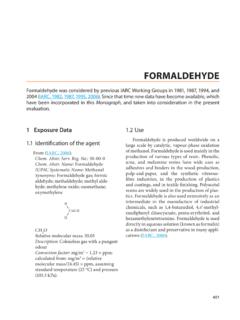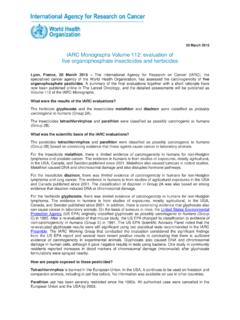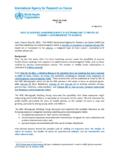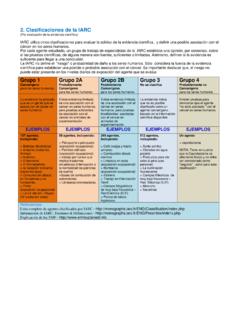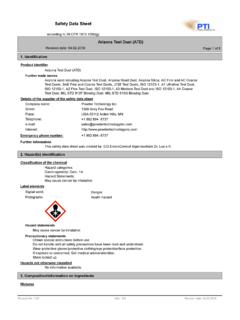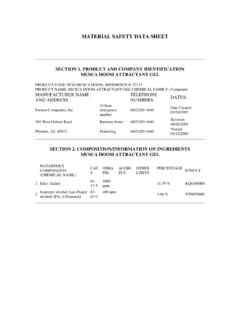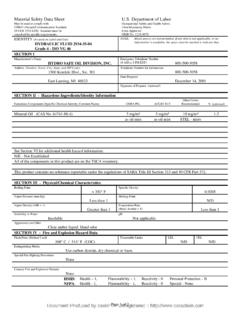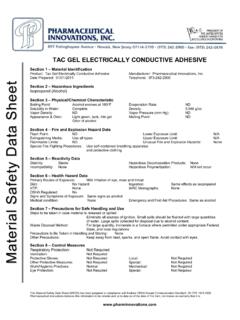Transcription of The IARC Monographs - WHO
1 1 International Agency for Research on CancerLyon, FranceUpdate of the scientific evidence on asbestos and cancerWorld Health OrganisationAsturias, 17 March 2011 Kurt Straif, MD MPH PhDThe iarc MonographsConsensus evaluationsof the weight of the evidence that an agent can increase the risk of cancer in humansApproximately 900 agents evaluated since 19711 - carcinogenic to humans 110 2A - probably carcinogenic to humans 64 2B - possibly carcinogenic to humans 243 National and international health agencies use the Monographs As a source of information to identify potentialcarcinogens As scientific support for their actions to prevent cancer2 iarc Monographs .
2 Volume 100 A Review of Human Carcinogens Scope of volume 100 Update the critical review for each carcinogen in Group 1 Identify tumour sites and plausible mechanisms Compile information for subsequent scientific publications The volume was developed over the course of 6 meetingsA. Pharmaceuticals(23 agents, Oct 2008)B. Biological agents(11 agents, Feb 2009)C. Metals, particles and fibres(14 agents, Mar 2009)D. Radiation(14 agents, June 2009)E. Lifestyle factors(11 agents, Sept 2009)F. Chemicals and related occupations(34 agents, Oct 2009)Straif et al, Lancet Oncol, 20093 iarc Monographs on AsbestosSerpentinesChrysotile(White asbestos)AmphibolesActinolit Amosite Anthophyllite Crocidolite Tremolite(Brown asbestos)(Blue asbestos)AsbestosIARC Monographs on AsbestosActinolite, amosite, anthophyllite, chrysotile, crocidolite, tremolite Vol 2, 1973: sufficient evidence in humans, sufficient evidence in animals (1) Vol 14, 1977: sufficient evidence in humans, sufficient evidence in animals (1) Suppl 7,1987: sufficient evidence in humans, sufficient evidence in animals, 1.
3 Mesothelioma and lung cancer, V100C The epidemiologic evidence has only strengthened over time and there is currently overwhelming evidence that all commercial forms of asbestos fibers are causally associatedwith an increased risk of mesothelioma and lung cancer. There are still current controversiesabout the extent to which there are potency differences for the particular formsof asbestos ( chrysotile versus amphiboles) and sizes( long and thin fibers). However, these issues do not alter the fundamental conclusion that the epidemiologic evidence indicates that all forms and sizes of commercial asbestos fibers are carcinogenic to humans. Exposure to asbestos and mesothelioma mortality in UKAdapted from Hodgson et al, 20055 Asbestos: open questions Lung cancer potency varies by fiber type?
4 Pro review by Hodgson & Darton 2000 (10x), con review by Stayner et al. 1996 Lung cancer potency varies by fiber size?indirect epidemiologic evidence (textile industry) supports belief that fibers > 10 m have higher carcinogenic potency for lung cancer Mesothelioma potency varies by fiber type?chrysotile < amphiboles, amosite may be < crocidolite, but: mesothelioma among Chinese workers exposed to pure chrysotile (Yano 2001) Mesothelioma potency varies by fiber size?pro: mesothelioma at South Carolina > Quebec miners con: South Carolina textile < New Orleans cement plantChrysotile and cancer recent epidemiological evidence Cohort of 5782 workers of 4 textile plants in NC, USA, followed-up 1950-2003.
5 Lung cancer SMR (95%CI ), mesothelioma SMR (95%CI );RR increased with time since first employment and duration of employment (Loomis et al, 2007) Cluster of 14 mesothelioma cases among workers who were active in the Balangero mine, Italy, and 13 among other people exposed to Balangero chrysotile adds further evidence to the carcinogenicity of tremolite-free chrysotile(Mirabelli et al, 2008). Cohort of 3072 workers of 1 textile plant in SC, USA, followed-up 1940-2001. Lung cancerwas most strongly associated with exposure to thin (< m) and longer (> 10 m) fibers (TEM)(Stayner et al, 2008)6 Asbestos: Laryngeal cancer, V100C Fairly consistent findingsof both the occupational cohort studies as well as the case-control studies, plus the evidence for positive exposure-response relationshipsbetween cumulative asbestos exposure and laryngeal cancer that is reported in several the well conducted cohort studies.
6 Meta-analyses of 29 cohort studiesencompassing 35 populations and of 15 case-control studiesof asbestos exposure and laryngeal cancer undertaken by the Institute of Medicine (2006). There is sufficient evidenceto infer a causal relationship between asbestos exposure and laryngeal and Ovarian CancerCamargo et al (subm.)7 Asbestos: colorectal cancer, V100 CRR 1 3 5 10RR of colorectal cancer among people in highest exposure category compared to non-exposedAsbestos: mechanistic data, V100C The mechanistic basis for asbestos carcinogenicity is a complex interactionbetween these crystalline mineral fibres and target cells in vivo.
7 The most important physicochemical properties of asbestos fibresrelated to pathogenicity are surface chemistry and reactivity, surface area, fibre dimensions, and biopersistence. Multiple direct and indirect mechanismshave been proposed based on numerous in-vitro cellular assays and acute and subchronicanimal bioassays. These complex mechanisms most likely interact at multiple stages during the development of lung cancer and diffuse malignant : mechanistic data, V100 CSpecies differences There are significant species differencesin the responses of the respiratory tract to inhalation of asbestos fibres. The biological mechanismsresponsible for these species differences are unknown.
8 Based on comparative animal experimental studies, there may be differences in deposition and clearance of fibres in the lungs, in severity of fibrosis, in kinetics of translocation of fibres to the pleura, and in levels or types of antioxidant defence : Overall evaluations, V100C There is sufficientevidence in humans for the carcinogenicity of all forms of asbestos (chrysotile, crocidolite, amosite, tremolite, actinolite and anthophyllite). All forms of asbestoscause mesotheliomaand cancers of the lung, larynx and ovary. The Working Group classified the evidence for colorectal canceras limitedalthough the Members were evenly divided as to whether the evidence was strong enough to warrant classification as sufficient.
9 There is limitedevidence in humans for cancers of the pharynxand of the stomach. 9 Burden of asbestos-related cancerRecently, several new global and national estimates of attributable fractions (AF) for occupational cancer have been published- Nurminen & Karjalainen, Finland (2001);- Steenland et al, USA (2003);- Driscoll et al, WHO GBD (2005);- Rushton et al, UK (2008)Used different methods to estimates asbestos-related lung cancer(based on mesothelioma mortality and mesothelioma/lung cancer ratio estimate; Levin s or Miettinen s equation)UK Burden of Occupational CancerAll iarc Group 1 and 2A carcinogens with strong or suggestive evidence for specific site in humans (Siemiatycki et al, 2004)Rushton et al, Occ Env Med.
10 2008. 10 Burden of asbestos-related cancer85-90% of male mesotheliomacases due to occupational asbestos exposureAmong men, 17-29% of all lung cancerdue to occupational exposureLung canceraccounted for 54-75% of occupational cancerAsbestosaccounted for ca. 50% of occupational lung , Occ Env Med, 2008










